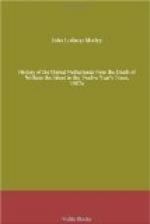It was, however, found necessary to retain some members of the former Government. Fuentes, the best soldier and accounted the most dangerous man in the empire, was indeed kept in retirement as governor of Milan, while Cristoval di Mora, who had enjoyed much of the late king’s confidence, was removed to Portugal as viceroy. But Don John of Idiaquez, who had really been the most efficient of the old administration, still remained in the council. Without the subordinate aid of his experience in the routine of business, it would have been difficult for the favourite to manage the great machine with his single hand. But there was no disposition on the part of the ancient minister to oppose the new order of things. A cautious, caustic, dry old functionary, talking more with his shoulders than with his tongue, determined never to commit himself, or to risk shipwreck by venturing again into deeper waters than those of the harbour in which he now hoped for repose, Idiaquez knew that his day of action was past. Content to be confidential clerk to the despot duke, as he had been faithful secretary to the despot king, he was the despair of courtiers and envoys who came to pump, after having endeavoured to fill an inexhaustible cistern. Thus he proved, on the whole, a useful and comfortable man, not to the country, but to its autocrat.
Of the Count of Chinchon, who at one time was supposed to have court influence because a dabbler in architecture, much consulted during the building of the Escorial by Philip II. until the auditing of his accounts brought him into temporary disgrace, and the Marquises of Velada, Villalonga, and other ministers, it is not necessary to speak. There was one man in the council, however, who was of great importance, wielding a mighty authority in subordination to the duke. This was Don Pietro de Franqueza. An emancipated slave, as his name indicated, and subsequently the body-servant of Lerma, he had been created by that minister secretary of the privy council. He possessed some of the virtues of the slave, such as docility and attachment to the hand that had fed and scourged him, and many vices of both slave and freedman. He did much of the work which it would have been difficult for the duke to accomplish in person, received his fees, sold and dispensed his interviews, distributed his bribes. In so doing, as might be supposed, he did not neglect his own interest. It was a matter of notoriety, no man knowing it better than the king, that no business, foreign or domestic, could be conducted or even begun at court without large preliminary fees to the secretary of the council, his wife, and his children. He had, in consequence, already accumulated an enormous fortune. His annual income, when it was stated, excited amazement. He was insolent and overbearing to all comers until his dues had been paid, when he became at once obliging, supple, and comparatively efficient. Through him alone lay the path to the duke’s sanctuary.




